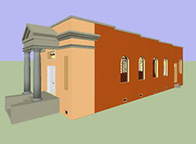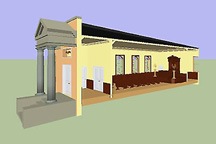It is not only rare for a building of this type and vintage
to be named for a woman, but also to have real architectural distinction.
From the beginning it was a whole-town effort with the land and
much of the material donated by the non-Jewish community, which
the congregation repaid in time by permitting many other groups
to use it. It remains today in the hands of the Jewish community
of Bryan-College Station but is currently used as a church.

The Greek-revival style and details effectively emphasize the
original Reform congregation's idea of "temple" as a
theological and aesthetic concept. It had almost nothing in common
with the Eastern-European "shule" or its small-town
American counterparts. The grace and subtlety of its execution
suggest the hand of an architecturally-trained designer.

The interior plan consists of a foyer with flanking wc and service rooms, the main sanctuary, and meeting room in the rear. Despite its small size (60' x 25' overall) the floor is raked, effectively (and conceptually) separating the congregation from the activity on the pulpit as it would be in a theater. Contrast this style of worship with the Orthodox Shule in Brenham with its central bimah where the congregants would have actively participated in and led the services.
The building is not long for this world: its wood trim visibily
decayed, masonry cracked, and many stained and plain glass windows
broken. National Historic Registry only insures a peaceful demise.
Bryan and Temple Freda have had a checkered history, filled with colorful, sometimes contentious, characters. The Palace, Queen, and Dixie theaters were owned by a local Jewish empressario, who came to a suitably theatrical end. While the Queen still wears her crown, the Palace' roof caved in some years ago and is preserved as an open-air theater